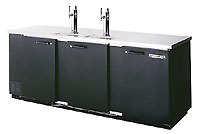The Kegerator Solution
 What is a Kegerator? According to Wikipedia: "Kegerator is a term used to describe a home made beer dispensing device. A keg, typically of beer, is stored in a refrigerated container in order to keep the keg chilled. The user is able to maintain a tapped keg in such a device for extended periods of time, usually a couple months, without losing any quality in the taste of the beer. Normally they are made from a refrigerator or a freezer with special equipment. The term "Kegerator" is a portmanteau combining the words keg and refrigerator."
What is a Kegerator? According to Wikipedia: "Kegerator is a term used to describe a home made beer dispensing device. A keg, typically of beer, is stored in a refrigerated container in order to keep the keg chilled. The user is able to maintain a tapped keg in such a device for extended periods of time, usually a couple months, without losing any quality in the taste of the beer. Normally they are made from a refrigerator or a freezer with special equipment. The term "Kegerator" is a portmanteau combining the words keg and refrigerator."Let's face it - it is expensive to go to the bar with your friends, not to mention the hazardous trip back home after a good embibing. It's cheaper, safer and much more convenient to bring the bar home. Extra bonuses include controlling the background music and a BBQ in the back yard just waiting for a juicy steak or hamburger to enhance the experience. Here is a simple cost break down of buying beer in a six pack vs buying a half keg:
Not only do beer cans and bottles occupy valuable refrigerator space they also have to be stored and recycled. Approximately 165 12-ounce beer containers equal the amount of beer in a 1/2 keg. The average 1/2 keg of beer costs about $60.00 and average six pack of beer is $5.00. To equal the same amount of beer in a keg you would spend about $140.00 on six packs. You save $80.00 by purchasing a 1/2 keg of beer. If you add it up, ten 1/2 kegs of beer will save you $800 – the Kegerator has just paid for itself! As if that weren't enough, a kegerator will keep your beer fresh for at least 2 months! Why waste all that money on bottled or canned beer when you can pull a fresh tasty cold draft beer from a kegerator?
Beverage Air kegerators are built like a tank. Capable of holding from 1 to 5 kegs of beer, most kegerators can be purchased with a wheeled casters kit, essentially turning the kegerator into a
 mobile bar. This set up is perfect for outdoor events, beer gardens, venues and the like. Upgrading to the Club Top offers top side access the the interior and a handy shelf to store your frosty cold mugs. Beverage Air Keg Coolers feature solid chassis and large, easy opening doors for quick keg changeouts. Stainless steel countertops and tough vinyl coated sides mean will withstand years of use.
mobile bar. This set up is perfect for outdoor events, beer gardens, venues and the like. Upgrading to the Club Top offers top side access the the interior and a handy shelf to store your frosty cold mugs. Beverage Air Keg Coolers feature solid chassis and large, easy opening doors for quick keg changeouts. Stainless steel countertops and tough vinyl coated sides mean will withstand years of use.The history of beer is closely interwoven with the history of mankind. Find out more on this fascinating site detailing the History of Beer. Believe it or not, beer can acutally benefit your health. As Thomas Jefferson says, "Beer, if drank in moderation, softens the temper, cheers the spirit, and promotes health." Apparently a recent study has proven that beer, especially darker brews, are rich in antioxidants. A second study showed that people who consumed one alcoholic beverage daily reduced their risk of developing cataracts by half, again thanks to antioxidants.
Beer Key
All beers fall into one of two categories: either lagers or ales. Lagers are made from bottom-fermenting yeast and are generally smooth beers. Ales are made from top-fermenting yeast and are hearty and robust.
Ale: A spicy beer with a red-amber color
Bock: A strong lager, usually brewed in winter in anticipation of spring

Bitter: A golden-brown, top-fermented beer
Lambic: A wheat beer originally produced in Belgium
Lager: A typical "American" mainstream beer, gold in color
Pale ale: A British-style beer that is crisp and bitter.
Pilsner: A pale golden beer with a crisp taste
Porter: A dark, top-fermented beer
Stout: A dark brownish-black beer, sometimes with a coffee-like flavor
What is beer exactly? How do you Make it? We've got those answers and, for your home brewing pleasure - beer recipies! and more beer recipies! Click here for beer tasting tips from BellaOnline. Bottoms up!

<< Home